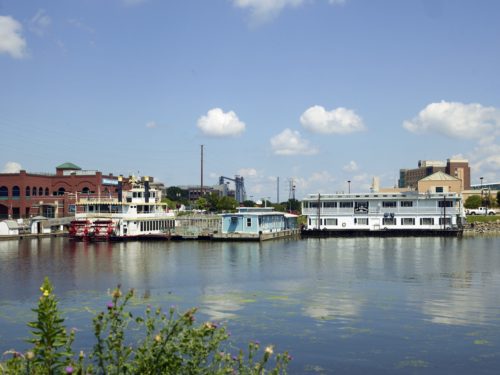
Riverboats and a dredge in the harbor at Dubuque. Photo by Carol Highsmith, courtesy of Library of Congress, LC-DIG-highsm-39839
By Susan Miller Hellert
Dubuque’s early history is omnipresent; some of which can be seen once you familiarize yourself with it.
Located on the banks of the Mississippi River in the Driftless Region, Dubuque possessed both mineral resources and accessibility to help make it a key city in Iowa’s early development. Due to the absence of the last glaciers 12,000 years ago, the land surrounding Dubuque had not been scoured flat or covered with glacier debris. The steep hills and deep valleys offered rich deposits of lead.
Following river highways from Canada, the French Canadians were the first to discover these riches. The native population surface mined the lead for decorations and trade as far away as the Rocky Mountains and the Gulf of Mexico. Nicolas Perrot arrived in the 1600s to supply a world hungry for lead ammunition. Father Jacques Marquette, a Jesuit missionary, and Louis Joliet, an experienced map maker and geographer, came to explore and seek a Northwest Passage to the Pacific Ocean. They left the area now known as Green Bay, Wis., on May 17, 1673, and arrived at the confluence of the Mississippi and Wisconsin rivers “with a joy we cannot express” on June 17, 1673. They found no Northwest Passage, but did find “iron mines” which were the Dubuque lead mines.
Between 1712 and 1737 the French, with assistance from American Indian allies, conducted a war of genocide against the Fox (Mesquakie) Indians pushing the survivors across the Mississippi River. Intensely protective of their lands, the Mesquakie allowed few outsiders in their territory. In 1788, Julien Dubuque, the man for whom the city and county were named, arrived from what today is known as Prairie du Chien, Wis., via Green Bay and French Canada. He rapidly became a trading partner with the Mesquakie who found him to be a friend. In 1796, he received the confirmation of his mining rights from the Mesquakie in the Mines of Spain from the Spanish governor as the territory was officially owned by Spain.
TO READ THE ENTIRE STORY AND OTHER FASCINATING STORIES ABOUT IOWA HISTORY, subscribe to Iowa History Journal. You can also purchase back issues at the store.
